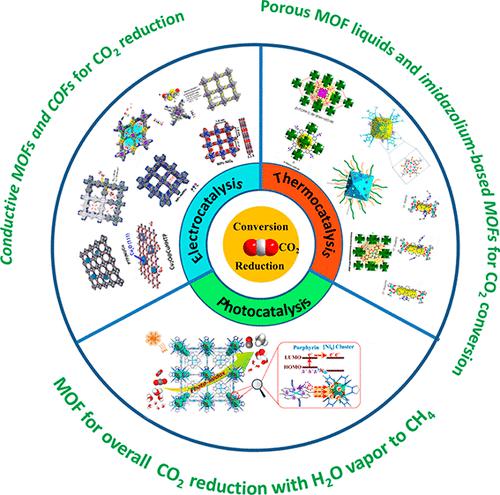当前位置:
X-MOL 学术
›
Acc. Chem. Res.
›
论文详情
Our official English website, www.x-mol.net, welcomes your feedback! (Note: you will need to create a separate account there.)
Thermo-, Electro-, and Photocatalytic CO2 Conversion to Value-Added Products over Porous Metal/Covalent Organic Frameworks
Accounts of Chemical Research ( IF 18.3 ) Pub Date : 2022-09-26 , DOI: 10.1021/acs.accounts.2c00326 Qiu-Jin Wu 1, 2 , Jun Liang 1, 3 , Yuan-Biao Huang 1, 2 , Rong Cao 1, 2, 4
Accounts of Chemical Research ( IF 18.3 ) Pub Date : 2022-09-26 , DOI: 10.1021/acs.accounts.2c00326 Qiu-Jin Wu 1, 2 , Jun Liang 1, 3 , Yuan-Biao Huang 1, 2 , Rong Cao 1, 2, 4
Affiliation

|
The continuing increase of the concentration of atmospheric CO2 has caused many environmental issues including climate change. Catalytic conversion of CO2 using thermochemical, electrochemical, and photochemical methods is a potential technique to decrease the CO2 concentration and simultaneously obtain value-added chemicals. Due to the high energy barrier of CO2 however, this method is still far from large-scale applications which requires high activity, selectivity, and stability. Therefore, development of efficient catalysts to convert CO2 to different products is urgent. With their well-engineered pores and chemical compositions, high surface area, elevated CO2 adsorption capability, and adjustable active sites, porous crystalline frameworks including metal–organic frameworks (MOFs) and covalent organic frameworks (COFs) are potential materials for catalytic CO2 conversion. Here, we summarize our recent work on MOFs and COFs for thermocatalytic, electrocatalytic, and photocatalytic CO2 conversion and describe the structure–activity relationships that could guide the design of effective catalysts.
中文翻译:

多孔金属/共价有机框架上的热催化、电催化和光催化 CO2 转化为增值产品
大气CO 2浓度的持续增加引起了包括气候变化在内的许多环境问题。使用热化学、电化学和光化学方法催化转化 CO 2是降低 CO 2浓度并同时获得增值化学品的潜在技术。然而,由于CO 2的高能垒,该方法距离要求高活性、选择性和稳定性的大规模应用还很遥远。因此,迫切需要开发将CO 2转化为不同产物的高效催化剂。凭借其精心设计的孔隙和化学成分、高表面积、升高的 CO 2吸附能力和活性位点可调,包括金属有机骨架(MOFs)和共价有机骨架(COFs)在内的多孔晶体骨架是催化CO 2转化的潜在材料。在这里,我们总结了我们最近在用于热催化、电催化和光催化 CO 2转化的 MOF 和 COF 方面的工作,并描述了可以指导有效催化剂设计的构效关系。
更新日期:2022-09-26
中文翻译:

多孔金属/共价有机框架上的热催化、电催化和光催化 CO2 转化为增值产品
大气CO 2浓度的持续增加引起了包括气候变化在内的许多环境问题。使用热化学、电化学和光化学方法催化转化 CO 2是降低 CO 2浓度并同时获得增值化学品的潜在技术。然而,由于CO 2的高能垒,该方法距离要求高活性、选择性和稳定性的大规模应用还很遥远。因此,迫切需要开发将CO 2转化为不同产物的高效催化剂。凭借其精心设计的孔隙和化学成分、高表面积、升高的 CO 2吸附能力和活性位点可调,包括金属有机骨架(MOFs)和共价有机骨架(COFs)在内的多孔晶体骨架是催化CO 2转化的潜在材料。在这里,我们总结了我们最近在用于热催化、电催化和光催化 CO 2转化的 MOF 和 COF 方面的工作,并描述了可以指导有效催化剂设计的构效关系。


























 京公网安备 11010802027423号
京公网安备 11010802027423号